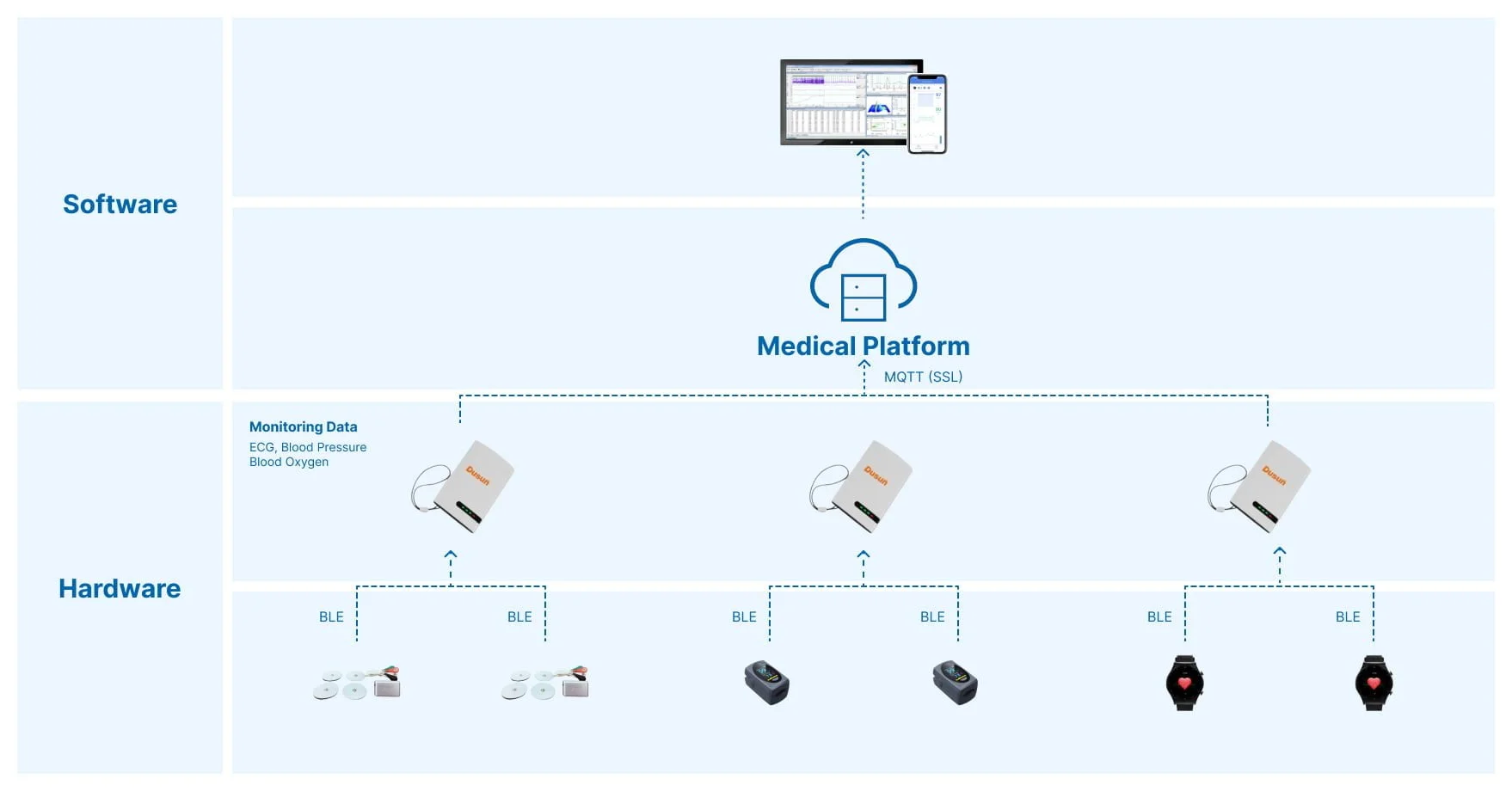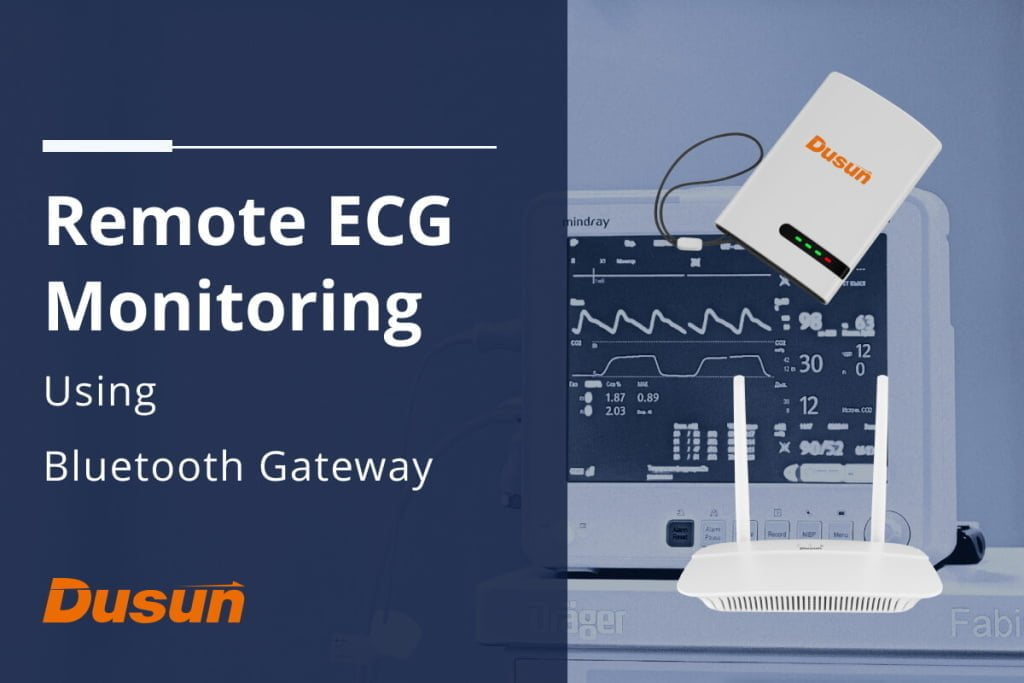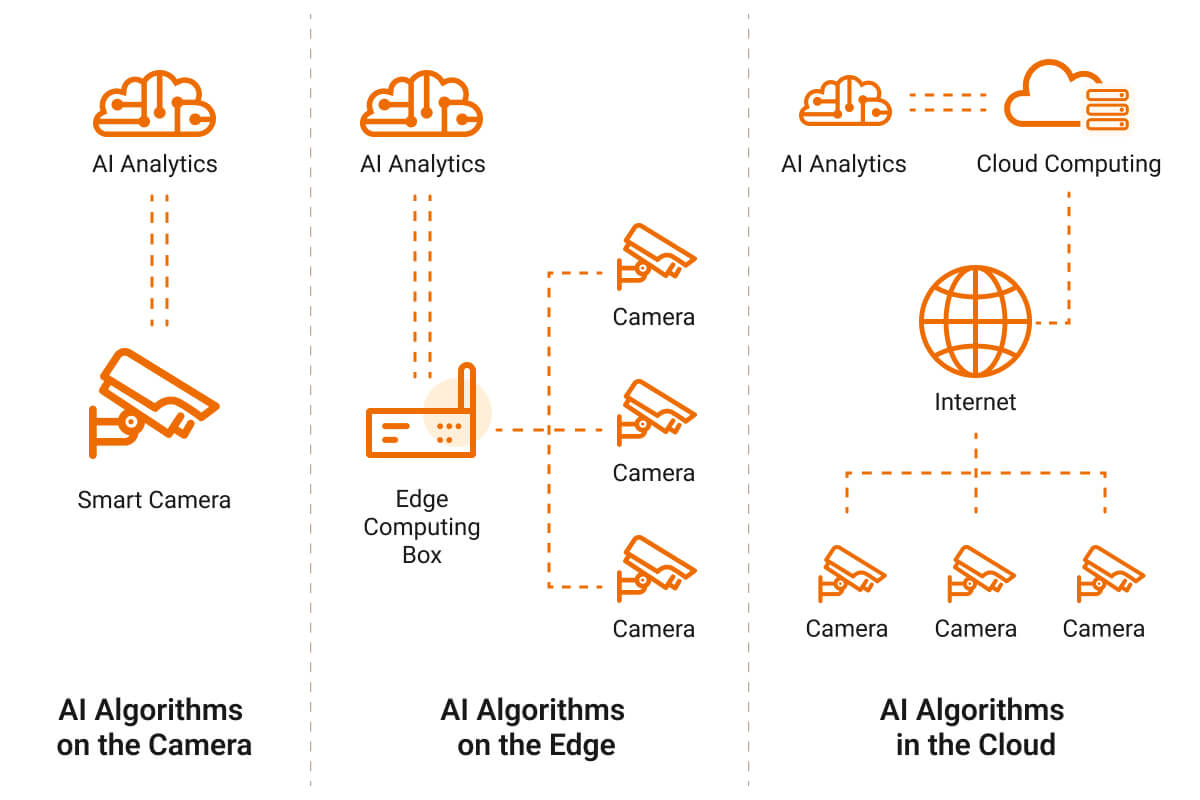Remote ECG monitoring is a promising technology that allows patients to monitor their heart health from the comfort of their homes. With the help of wearable remote ECG monitoring devices that collects ECG data, patients can transmit their data to a remote server via a Bluetooth gateway for analysis by healthcare providers.

Benefits of Remote ECG Monitoring
Remote ECG Monitoring enables healthcare providers to monitor the heart activity of patients who are not in the hospital or clinic, including those recently discharged or with chronic conditions. It allows immediate review of a patient’s electrocardiogram during symptoms or checking of heart rate or rhythm at any time, which helps detect certain arrhythmias or irregular heart rhythms causing symptoms. Here we list several benefits that can improve patient care and reduce healthcare costs.
Early Detection of Heart Diseases and Problems
Remote ECG monitoring allows for continuous monitoring of a patient’s heart activity, enabling early detection of any abnormal heart activity. It leads to early intervention and cure that can prevent severe heart conditions from developing.
Patient Comfort and Convenience
Remote ECG monitoring allows patients to continue their daily activities while providing healthcare professionals with the necessary data to monitor their heart activity. It improves their comfort and convenience.
Healthcare Cost Reduction
Remote ECG monitoring can reduce healthcare costs by reducing the need for hospital visits, reducing readmissions, and allowing for more efficient use of healthcare resources. It is particularly beneficial for patients with chronic heart conditions who require frequent monitoring.
Better Monitoring of Chronic Conditions
Remote ECG monitoring enables healthcare professionals to monitor a patient’s heart activity over an extended period, providing a more comprehensive picture of the patient’s heart health. It is necessary for patients with chronic heart conditions, as it allows for better monitoring and management of their condition.
Challenges of Remote ECG Monitoring
While remote ECG monitoring offers many benefits, it also poses several challenges described below.
Data Accuracy and Privacy
The accuracy and privacy of ECG data transmission are crucial for accurate diagnosis and patient confidentiality. To ensure this, secure data transmission protocols and compliance with data protection laws are necessary. Explore our Remote Patient Monitoring Device Solution to see how Dusun IoT improve this challenges.
Management of Large Data
Remote ECG monitoring generates large volumes of data, which is tough to manage and analyze. This requires the use of sophisticated data management and analysis tools to ensure that the data is processed and interpreted effectively.
Training for Patients and Healthcare Providers
Patients must be trained on how to use the device properly, and healthcare providers must be trained on how to interpret the data and make accurate diagnoses. This requires a significant investment in training and education, which can be challenging to implement.
Benefits of Using Bluetooth gateway in the Remote ECG Monitoring
A Bluetooth gateway-based remote ECG monitoring transmits data wirelessly, extends the range, conserves the battery life of the remote ECG monitors, and connects multiple ECG monitors to a single server. By adding Bluetooth roaming technology, the Bluetooth roaming gateway which can ensure seamless data transmission, can help IoT healthcare solutions by improving the functionality of a remote ECG monitoring system, like providing healthcare providers with real-time patient data without intervention, and patients can move around the facility regardless of where they are located.
Bluetooth Gateway Ensures More Stable Monitoring and Data Transmission
You may wondering if i can use my smart phones to upload data to the cloud server, why should i add a Bluetooth gateway? That’s a good question. Transferring data by smart phones is quite convenient for patients, but healthcare providers want to acquire dynamic vital sign data in real time, that means long-term continuous monitoring to capture occasional abnormal conditions for doctors to diagnose.
Although nowadays, the battery capacity of mobile phones is very good, but people use mobile phones for many reasons, like browsing social medias, watching videos. The power consumption of mobile phones is so high, and it may not guarantee the continuous monitoring of ECG data. In other words, using cellphone is hard to guarantee stable data transmission due to its malfunctions.
Bluetooth Gateway Usually Get FDA Approved, Which Means Meeting Medical Grades
On the other hand, and also the most important one, is that the ECG data collected and uploaded by ordinary mobile phones does not have high medical value and can only be used as a health reference. If a remote ECG monitoring device company wants to deploy remote ECG monitoring solutions for hospitals and provide medical-grade ECG data approved by doctors as a diagnosis reference, they need to deploy Bluetooth gateways or proprietary mobile phones to meet the requirements.
The Bluetooth gateway ensures that the data acquired and transmitted by dynamic ECG monitoring device is effective, stable, and medically valuable than cellphones.
Working Principle of Remote ECG Monitoring
ECG Recording Device
The ECG recording device for remote monitoring is a small, portable device with sensors that detect the heart’s electrical signals and records data for analysis. It may include additional sensors for measuring other vital signs, allowing for a more comprehensive view of the patient’s health and aiding in diagnosis and treatment.
Remote ECG Transmission
The ECG data recorded by a device is transmitted wirelessly in real-time to Bluetooth gateway, and then the gateway use cellular or Wi-Fi connections for more reliable and secure data transmission. Although you can use any wireless gateway, Dusun IoT provides a portable Bluetooth to Wi-Fi/LTE Gateway for wearable medical devices that add more convenience.
Data Storage on Cloud
Transmit the ECG data from the Bluetooth gateway to a remote server or cloud-based platform for storage and analysis. This platform provides secure and accessible storage for the data, enabling healthcare professionals to access it from anywhere with an internet connection. Additionally, the central location of the data allows for easier tracking of changes in a patient’s health over time.
Graphical User Interface
It is an essential component of a remote ECG monitoring system. The GUI displays ECG data stored on a cloud clearly and concisely, providing real-time monitoring, trend analysis, and alerts for abnormal heart activity. The GUI can be modified to meet the specific needs of healthcare professionals, making it easy for them to interpret the data in a way that is most useful for their practice.
Types of Remote ECG Monitoring Devices
Various remote ECG monitoring devices are available, each with several advantages and disadvantages.
Wearable ECG Devices
These are the most popular type of remote ECG monitoring devices available. You can wear these devices like a smartwatch or chest strap and track heart activity over an extended period. Wearable ECG devices are non-invasive, easy to use, and offer continuous monitoring of a patient’s heart activity.
Implantable ECG Devices
Implantable ECG devices are implanted under the skin and offer long-term monitoring of a patient’s heart activity, particularly for those at high risk of heart disease or those who have had a heart attack. They provide continuous and accurate heart monitoring.
Smartphone-based ECG Devices
You can easily connect these small devices to your smartphone to monitor the patient’s heart activity. Smartphone-based ECG devices are easy to use and offer a quick and convenient way to monitor heart activity.
Handheld ECG Devices
Portable handheld ECG devices monitor a patient’s heart activity while on the go. These devices are easy to use and provide a quick and convenient way to monitor heart activity.
Remote ECG Monitoring Device Users
Remote ECG monitoring solutions allow the collection and analysis of ECG data in a non-invasive and convenient way, making it an ideal solution for many patients.
Patients with Chronic Heart Disease
Remote ECG monitoring can benefit patients with chronic heart disease by allowing healthcare professionals to track changes in their heart activity over time, thus preventing complications and improving patient outcomes.
Patients at Risk of Developing Heart Disease
Remote ECG monitoring can help to identify any signs of heart disease early, making it easier to manage and treat the condition. Early detection and treatment can prevent serious complications and improve overall health.
Patients Recovering from Heart Disease
Remote ECG monitoring enables healthcare professionals to monitor the patient’s heart activity and adjust their treatment plan as needed, resulting in a smoother and more successful recovery process.
Patients Taking Medications that Affect Their Heart Function
Regular remote ECG monitoring can benefit patients taking medicines that affect their heart function by monitoring any adverse effects of the treatment. Healthcare professionals can adjust the patient’s medication plan to ensure the best possible outcome.
Patients with an Implanted Cardiac Device
Remote ECG monitoring can benefit patients with an implanted cardiac device such as a pacemaker or defibrillator. It allows healthcare professionals to track the device’s performance and identify the issues early on to ensure that the patient receives the best possible care.
Future of Remote ECG Monitoring
Remote ECG monitoring has already made significant strides in improving the diagnosis and management of heart disease, and it is poised for further advancements in the future. Here are some of the key trends that are likely to shape the future of remote ECG monitoring:
Integration with Artificial Intelligence
The integration of AI and machine learning algorithms can improve the accuracy and efficiency of remote ECG monitoring by identifying patterns in the data that human providers may miss.
Advanced Monitoring Devices
The trend towards developing smaller, more comfortable, and easier-to-use ECG monitoring devices are expected to make remote ECG monitoring more accessible and convenient for patients in the future.
Remote Monitoring of other Vital Signs
Along with remote ECG monitoring, it is expected that other vital signs, such as blood pressure, respiratory rate, continuous glucose monitoring and oxygen saturation, will also be monitored remotely. This will give healthcare providers a more comprehensive view of a patient’s health, allowing for more personalized and targeted care.



















